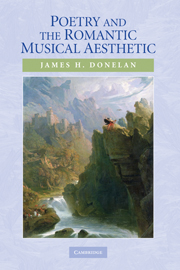Book contents
- Frontmatter
- Contents
- List of Musical Examples
- Acknowledgments
- Preface: The Sound and the Spirit
- Chapter 1 Self-Consciousness and Music in the Late Enlightenment
- Chapter 2 Hölderlin's Deutscher Gesang and the Music of Poetic Self-Consciousness
- Chapter 3 Hegel's Aesthetic Theory: Self-Consciousness and Musical Material
- Chapter 4 Nature, Music, and the Imagination in Wordsworth's Poetry
- Chapter 5 Beethoven and Musical Self-Consciousness
- Chapter 6 The Persistence of Sound
- Notes
- Bibliography
- Index
Chapter 6 - The Persistence of Sound
Published online by Cambridge University Press: 22 September 2009
- Frontmatter
- Contents
- List of Musical Examples
- Acknowledgments
- Preface: The Sound and the Spirit
- Chapter 1 Self-Consciousness and Music in the Late Enlightenment
- Chapter 2 Hölderlin's Deutscher Gesang and the Music of Poetic Self-Consciousness
- Chapter 3 Hegel's Aesthetic Theory: Self-Consciousness and Musical Material
- Chapter 4 Nature, Music, and the Imagination in Wordsworth's Poetry
- Chapter 5 Beethoven and Musical Self-Consciousness
- Chapter 6 The Persistence of Sound
- Notes
- Bibliography
- Index
Summary
Two hundred years have passed since the premiere of Beethoven's Fifth and Sixth Symphonies, the publication of Hegel's Phenomenology, the end of Wordsworth's Golden Decade, and the beginning of Hölderlin's madness, yet their influence is everywhere. Beethoven's works are performed, recorded, and downloaded more often than any composer except for perhaps Mozart. Hegel's works are selling well, if not briskly, in any bookstore of reasonable size; his influence among intellectuals in many fields rivals that of Aristotle and Machiavelli. Wordsworth is an industry, with new editions of his poetry, along with biographies and critical works, coming out at a steady rate. Even Hölderlin, who languished in obscurity for nearly a century, has many editions and translations going into multiple printings; his major critics, Heidegger, Szondi, Adorno, Henrich, and de Man, have themselves become objects of study. These four figures –, Hölderlin, Hegel, Wordsworth, and Beethoven – occupy a greater place in the cultural imagination than ever, for reasons that have nothing to do with profit motives, official approval, or nostalgia. They remain important simply because their works address issues of identity, freedom, and beauty that still matter.
Still, I feel obligated to make a brief case for their continued relevance that goes beyond the mere observation that so many people still find them important – too many intelligent writers have argued that their popularity is not necessarily the direct result of genuine value and that their works are merely artifacts of a more naïve era.
- Type
- Chapter
- Information
- Poetry and the Romantic Musical Aesthetic , pp. 176 - 178Publisher: Cambridge University PressPrint publication year: 2008

